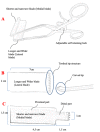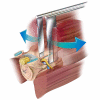Minimally Invasive Far-Lateral Microdiscectomy: A New Retractor for Far-Lateral Lumbar Disc Surgery
- PMID: 33585114
- PMCID: PMC7872492
- DOI: 10.7759/cureus.12625
Minimally Invasive Far-Lateral Microdiscectomy: A New Retractor for Far-Lateral Lumbar Disc Surgery
Abstract
Background To date, a number of approaches have been described for far-lateral disc surgery, including midline, paramedian, and intertransverse approaches. These approaches pose challenges for surgeons due to the difficulty in retraction caused by the anatomy of the foramen. We designed a retractor suitable for the three-dimensional anatomical structure of the foramen. In this study, we aimed to evaluate the surgical outcomes of the patients who were operated on using this retractor in our clinic. Methods The retrospective study included patients who were operated on due to far-lateral disc herniation using the retractor designed in our clinic between February 2013 and December 2018. Results The study included 11 (64.7%) women and 6 (35.3%) men, with a mean age of 56 years (range: 42-70 years). The mean operative time was 49 minutes (range: 40-70 minutes), the mean estimated blood loss was 42 mL (range: 25-60 mL), and the mean follow-up period was 22.6 months (range: 13-48 months). No complication occurred in any patient. A minimally invasive discectomy was performed via the paramedian approach in each patient. The patients were evaluated using the visual analog scale (VAS) for radicular pain, Oswestry Disability Index (ODI), 36-Item Short Form Survey (SF-36), and the modified MacNab criteria. Conclusion The retractor developed in our study provided numerous benefits during the surgical procedure as it led to minimal blood loss and reduced operative times by avoiding bone resection in extraforaminal discs and requiring minimal bone resection in foraminal discs.
Keywords: far-lateral disc herniation; microdiscectomy; minimally invasive spine surgery; new retractor.
Copyright © 2021, Ünsal et al.
Conflict of interest statement
The authors have declared that no competing interests exist.
Figures



Similar articles
-
Percutaneous transforaminal endoscopic discectomy compared with microendoscopic discectomy for lumbar disc herniation: 1-year results of an ongoing randomized controlled trial.J Neurosurg Spine. 2018 Mar;28(3):300-310. doi: 10.3171/2017.7.SPINE161434. Epub 2018 Jan 5. J Neurosurg Spine. 2018. PMID: 29303469 Clinical Trial.
-
Extraforaminal microscopic assisted percutaneous nucleotomy for foraminal and extraforaminal lumbar disc herniations.Spine J. 2018 Apr;18(4):620-625. doi: 10.1016/j.spinee.2017.08.258. Epub 2017 Sep 4. Spine J. 2018. PMID: 28882526
-
Direct Tubular Lumbar Microdiscectomy for Far Lateral Disc Herniation: A Modified Approach.Orthop Surg. 2016 Aug;8(3):301-8. doi: 10.1111/os.12263. Orthop Surg. 2016. PMID: 27627712 Free PMC article.
-
Tubular microdiscectomy: techniques, complication avoidance, and review of the literature.Neurosurg Focus. 2017 Aug;43(2):E7. doi: 10.3171/2017.5.FOCUS17202. Neurosurg Focus. 2017. PMID: 28760036 Review.
-
Percutaneous Endoscopic Lumbar Discectomy Versus Posterior Open Lumbar Microdiscectomy for the Treatment of Symptomatic Lumbar Disc Herniation: A Systemic Review and Meta-Analysis.World Neurosurg. 2018 Dec;120:352-362. doi: 10.1016/j.wneu.2018.08.236. Epub 2018 Sep 8. World Neurosurg. 2018. PMID: 30205219
Cited by
-
Transtubular Endoscopic Neuronavigation-Assisted Approach for Extraforaminal Lumbar Disk Herniations: A New Trend for a Common Neurosurgical Disease.Acta Neurochir Suppl. 2023;135:413-416. doi: 10.1007/978-3-031-36084-8_63. Acta Neurochir Suppl. 2023. PMID: 38153502
-
[Research progress of unilateral biportal endoscopy technique in treatment of lumbar related diseases].Zhongguo Xiu Fu Chong Jian Wai Ke Za Zhi. 2022 Oct 15;36(10):1234-1240. doi: 10.7507/1002-1892.202205087. Zhongguo Xiu Fu Chong Jian Wai Ke Za Zhi. 2022. PMID: 36310460 Free PMC article. Chinese.
References
-
- Frequency and specific surgical management of far lateral lumbar disc herniations. Siebner H, Faulhauer K. Acta Neurochir. 1990;105:124–131. - PubMed
-
- Long-term follow up of patients surgically treated by the far-lateral approach for foraminal and extraforaminal lumbar disc herniations. Porchet F, Chollet-Bornand A, Tribolet N. J Neurosurg Spine. 1999;90:59–66. - PubMed
-
- The surgical treatment of far lateral L3-L4 and L4-L5 disc herniations. a modified technique and outcomes analysis of 25 patients. Hodges S, Humphreys S, Eck J, Covington L. Spine (Phila Pa 1976) 1999;24:1243–1246. - PubMed
-
- Minimally invasive approach to far lateral lumbar disc herniation: technique and clinical results. Salame K, Lidar Z. Acta Neurochir (Wien) 2010;152:663–668. - PubMed
LinkOut - more resources
Full Text Sources
Other Literature Sources
